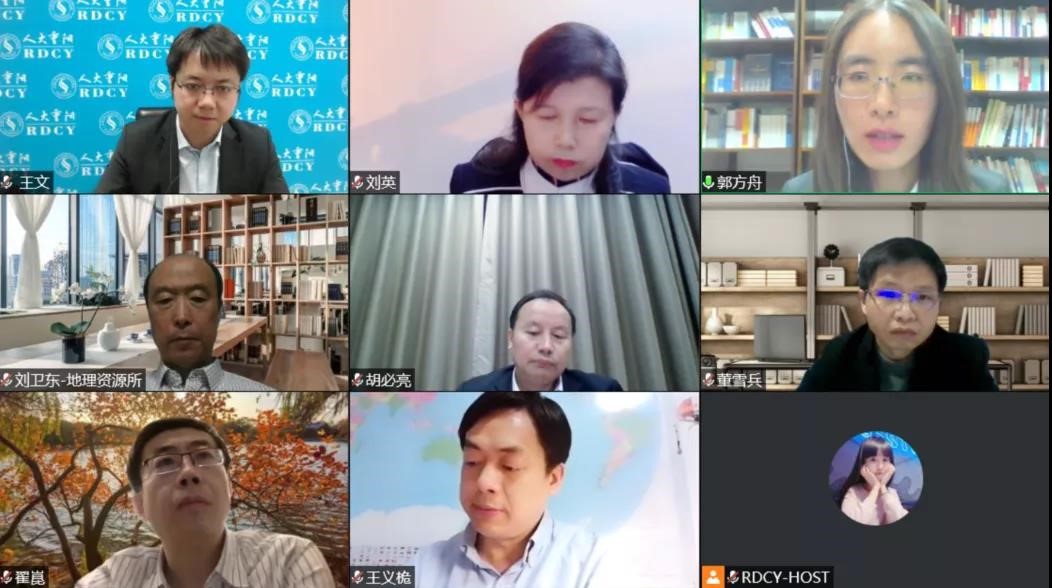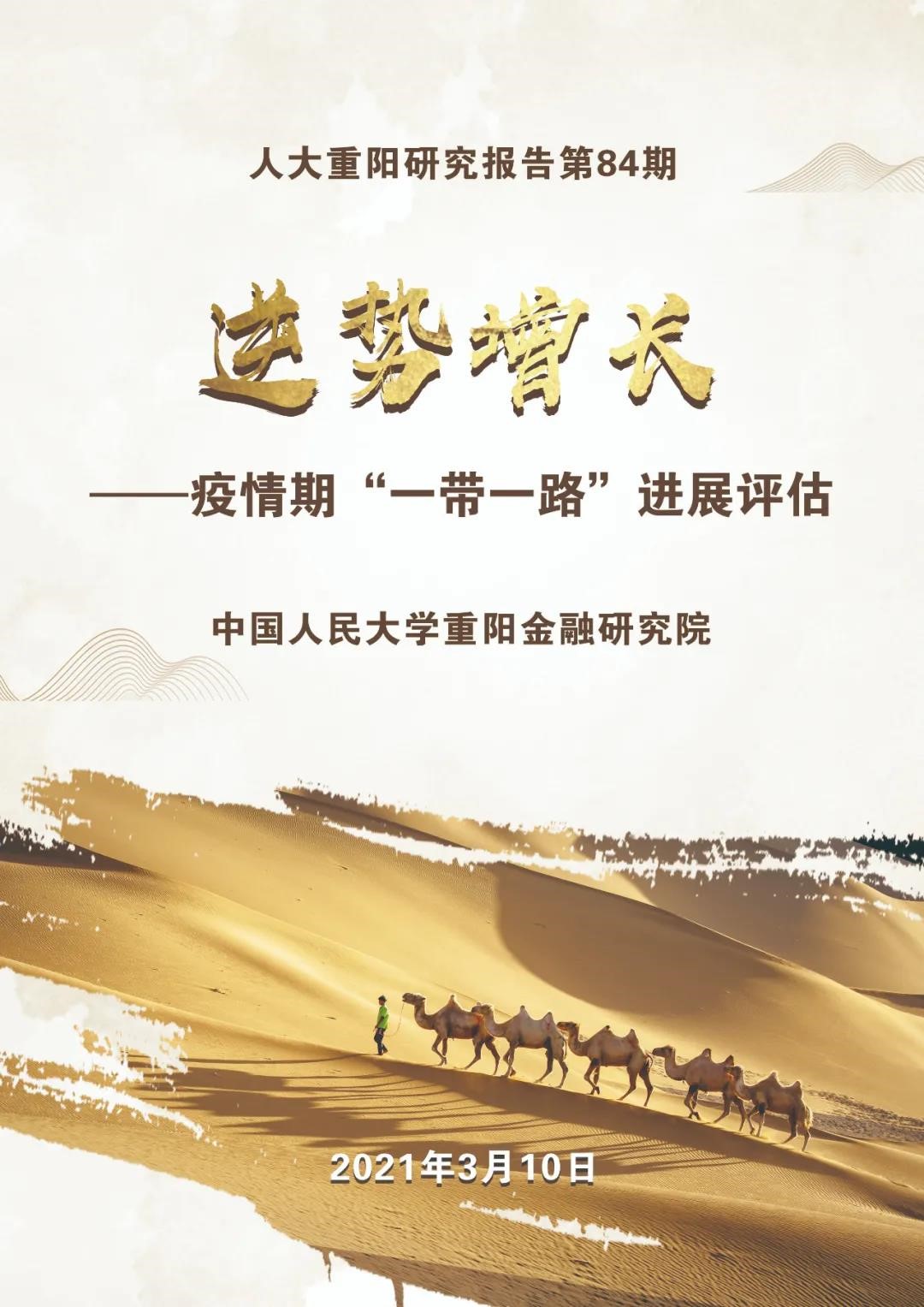Featured
Your Present Location: HOME> FeaturedSeminar on “Growth in Crisis: Assessment of the BRI Progress during the Covid-19 Epidemic” held successfully
On March 10, 2021, the Seminar on “Growth in Crisis: Assessment of the BRI Progress during the Covid-19 Epidemic” Online Conference hosted by Chongyang Institute for Financial Studies, Renmin University of China (RDCY) was successfully held. RDCY Executive Dean Wang Wen, RDCY Associate Researcher Guo Fangzhou, Director of the "Belt and Road" Strategic Research Center of the Chinese Academy of Sciences Liu Weidong, Executive Dean of the Belt and Road School of Beijing Normal University Hu Biliang, Deputy Dean of the Institute of Area Studies at Peking University (PKUIAS) Zhai Kun, Deputy Director of the Research Center for Regional Coordinated Development of Zhejiang University Dong Xuebing, and RDCY senior fellow Wang Yiwei gave their keynote speeches. Director of Cooperative Research Department of RDCY Liu Ying moderated this online conference.
At the opening, RDCY Executive Dean Wang Wen released the research report with theme of Growth in Crisis: Assessment of the BRI Progress during the Covid-19 Epidemic. The short version of his report has been published in the first issue of "the new Silk Road Review" in 2021.

Wang Wen expounded the background and main points of the report to the audience. First, this report uses data to show that, to many domestic and foreign scholars' surprise, during the epidemic, the BRI did not halt during the global lockdown as well as other adversities, it unexpectedly scored brilliant achievements. Whether it is in policy communication, facility connectivity, unimpeded trade, financial connectivity, and people-to-people exchanges, all the data showed that the "Belt and Road" is growing against the difficulties.
Second, the report systematically sorts out the important comments given by the Party and state leaders on the BRI.
Third, the report gives advices on the development of the BRI must integrate with the fight against Covid-19, economic recovery, and innovation. In the future, the "Belt and Road" will enter into the version 2.0 era, which means high-quality development and requires more in-depth research. Then, Guo Fangzhou, Associate Researcher of RDCY briefly supplemented the report from the perspective of facility connectivity.

In the keynote speech session, the experts highly recognized and acknowledged the report. They believed that the report data was informative and inspiring. They all agreed with the advices on the building of the "Belt and Road" discipline, and then shared the progress of the "Belt and Road" research over the past one year when Covid-19 was spreading through the world.
Liu Weidong, deputy director of the Institute of Geographical Resources of the Chinese Academy of Sciences and director of the "Belt and Road" Strategic Research Center, said that in the "Belt and Road" construction, the government is at the forefront, enterprises are also play a leading role, but the overall research done by scholars is indeed lagging behind the progress of "Belt and Road" construction and the requirements given by President Xi Jinping. Therefore, scholars should make a difference in this regard, appealing to the general public and striving to make the country pay more attention to academic research. To promote the high-quality development of the “Belt and Road” Initiative, we must put people-to-people exchange as our top priority. It is not optional, nor is it icing on the cake. In fact, people-to-people exchange is fundamental and leading, including research work and cooperation related to other aspects. We must call for the government to increase financial investment, using incremental funds to guide corporate funds and social funds, as well as setting up a number of targeted funds that aiming at improving people-to-people exchange.
Hu Biliang, Executive Dean of the Belt and Road School of Beijing Normal University, responded to last year’s doubts with six new opportunities and new trends in the “Belt and Road” construction in the post-covid-19 era. First, the "Belt and Road" has overcome many challenges and the total investment volume has increased significantly. Second, no country has fallen into a debt crisis due to participating in the “Belt and Road” construction. Third, we have jointly promoted energy transformation and development with related countries. Fourth, the dual circulation serves as the new momentum for international cooperation under the “Belt and Road” framework. Fifth, vaccine cooperation is a new field of international cooperation under the “Belt and Road” framework. Sixth, digitization is a new opportunity for the “Belt and Road” international cooperation.
Zhai Kun, Deputy Dean of the Institute of Area Studies at Peking University (PKUIAS), believes that seven critical changes have emerged in the BRI and must be carried forward during the 14th Five-Year Plan no matter how difficult they are. First, BRI has entered into the post-covid-19 era for development transformation. Second, the spatial layout of the “Belt and Road” has undergone a huge change. Third, the rise of endogenous momentum from local sectors in the “Belt and Road”. Fourth, BRI is growing to be capable of reshaping the industrial chain, value chain and supply chain. Fifth, the “Belt and Road” needs to coordinate development and security, and strengthen strategic management. Sixth, the positive opinions towards the “Belt and Road” in the world has begun to appear. Seventh, the BRI has become a resilient system characterized by knowledge, action and innovation.
Dong Xuebing, Deputy Director of the Research Center for Regional Coordinated Development of Zhejiang University and Executive Deputy Dean of the China Western Development Research Institute proposed that in the Sino-US trade friction and post-covid-19 era, the security and stability of the industrial chain and supply chain must be highly emphasized. Generally speaking, China now has certain advantages in the industrial system, domestic demand market, and institutional environment. Countries along the "Belt and Road" at different levels of development not only have the common pursuit for cooperation, but also face the competition for the value chain to climb and contest for expanding the demand market. However, the establishment of a mutually beneficial and win-win industrial chain and supply chain cooperation system also depends on the competition from external forces. China must unswervingly continue to promote cooperation model featuring high-quality development and technological innovation, pushing for deeper institutional opening and innovation, and nurturing stronger national development capabilities as well as self-control skills of the industrial chains.
Wang Yiwei, senior fellow of RDCY holds that Covid-19 has revealed BRI's vitality. It is not only growing against the adversities, but also restructuring and improving itself. The most important thing is that the world needs BRI, which further demonstrates China's status in globalization. We must quickly launch the "Belt and Road" discipline, and it cannot wait for long. It can be classified into several research categories such as the "Belt and Road" philosophy research, governance, development, economics, and cultural studies. The next step of our research can be the relationship between the BRI and RCEP, how the "Belt and Road" can promote multilateralism, and the reform of the "Belt and Road" and WTO.
Please Find us: Twitter: RDCYINST YouTube: RealRDCY LinkedIn: 人大重阳RDCY Facebook: RDCYINST Instagram: rdcyinst
Key Words: RDCY; Belt and Road; Research























































































 京公网安备 11010802037854号
京公网安备 11010802037854号





